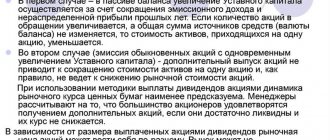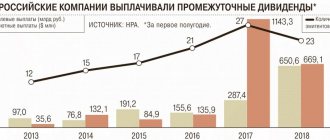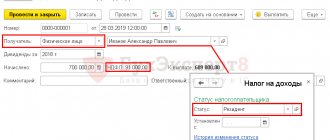Premiums: what an accountant needs to pay attention to
For length of service, special labor merits, or for holidays, memorable dates, etc., the employer has the right, at its discretion, to issue incentive (congratulatory) bonuses to employees. Payments are made based on an order signed by the head of the company. For this purpose, standard templates No. T-11 (for one employee) and No. T-11a (for several employees) are used. It is allowed to develop your own forms for such orders in the company, but taking into account the requirements of Federal Law No. 402 of December 6, 2011, Art. 9. Read the article in more detail: → Form T-11 and T-11a. Order on bonuses for employees in 2021.
The prescribed rules and regulations on the procedure for bonuses in local acts and employment contracts of the company are also taken into account. Mostly, this fact brings clarity and transparency to the grounds for applying bonuses and allows one to avoid labor disputes. Any changes (missing information or conditions) are made to the employment contract by separate agreement of the parties. At the same time, legal regulation regarding bonuses is carried out in accordance with the Tax and Labor Codes of the Russian Federation.
| Codes of the Russian Federation | Articles | Short description |
| Labor | 191 | incentives for work; |
| 135 | salary setting, including bonus system | |
| Tax | 255 | inclusion of bonuses in salary expenses; |
| 324.1 | accounting for the costs of creating a reserve for payments for length of service, vacations; | |
| 270 (p. 21-22) | tax-deductible expenses |
Information about incentives can be entered into the employees’ work book. Payments of cash bonuses are formalized and made using forms No. T-49, form No. T-53 (settlement and payment document), No. KO-2 (RKO - expense cash order) and by bank transfer.
What documents are used to document awards?
Documentation of such payments depends on the source of their financing.
The fact is that non-production bonuses can be issued either from retained earnings or from income received from the current activities of the organization. Let's consider each of these cases. Only the owners of the organization have the right to distribute funds remaining after taxation. This is indicated by Article 28 of the Federal Law of February 8, 1998 N 14-FZ “On Limited Liability Companies” and paragraph 11 of Clause 1 of Article 48 of the Federal Law of December 26, 1995 N 208-FZ “On Joint-Stock Companies” societies."
https://www.youtube.com/watch?v=https:tv.youtube.com
If the owners of the company did not record the decision to pay bonuses in the minutes, then we cannot say that the payment was made from retained earnings. Therefore, if the bonus is issued only by order of the manager, then this is clearly a current expense of the enterprise.
The order itself for the payment of bonuses is drawn up in any form. You can also use standard forms N T-11 and N T-11a. But in any case, the order must indicate the names of the employees receiving bonuses, the reason for payment and the amount.
You need to pay special attention to the design of awards. And all because the order according to which bonuses are reflected in accounting depends on the available documents.
Taxation and accounting of employee bonuses
The specifics of taxation of bonus incentives are largely determined by their type. Remunerations for special production results are included in salaries (expenses for ordinary activities) and can be either one-time or regular (monthly, quarterly, annually). They are included in cost. The employer has an obligation to pay such bonuses, since they are provided for by the payment system.
Non-production incentives are assigned as one-time payments, are not part of the salary, and are taken into account in other expenses for the reporting period. Such incentives are paid only according to the distribution of the head of the organization. When paying bonuses from a stock source based on the owner’s decision, they are attributed to the undistributed (or accumulated, accumulated) profit of previous years.
Thus, production bonuses are paid under agreements (collective, labor) and are associated with production and sales costs. They are economically justified and involve generating income. Conversely, incentives of a non-production nature are not related to the performance of employees’ job duties and tax expenses are not taken into account. According to the Tax Code of Russia, Art. 270, paragraph 21, they are not taken into account when calculating profit in expenses.
Regardless of the taxation regime, the following are calculated for all types of bonuses paid from net profit:
- Personal income tax (13% for tax residents of Russia);
- insurance payments (FSS - 2.0%, PFR - 22%, FFOMS - 5.1%, from accidents - 0.2%).
⊕ Insurance premium rates for 2021
Taxpayers here are individuals (individual entrepreneurs and citizens, residents of the Russian Federation). These are working people who have income. The bonuses received are part of this income at the place of employment.
Exceptions are presented in the list of the Tax Code of the Russian Federation, Article 217 (clauses 6, 7). This includes awards for outstanding achievements in the field of culture, science, technology, art, etc., as well as for senior officials. These types of income are not subject to taxes.
Capital investments when purchasing fixed assets
Since capital investments (purchase of fixed assets) involve large expenses, owners often order them to be paid from a special fund created from retained earnings. For example, at the expense of the production development fund.
It is important that the purchase of fixed assets must be reflected in the usual manner - through accounting accounts 08 (07) and 01. It does not matter from what sources the company paid for capital investments (from a special fund or not).
https://www.youtube.com/watch?v=ytaboutru
If the company pays for capital investments (purchase of property) using special funds, then also make internal entries to account 84 to show the use of funds.
What they often do wrong. They reflect the purchase of fixed assets at the expense of retained earnings, bypassing accounts 08 (07) and 01. Such assets are not depreciated either in accounting or tax accounting.
How to reflect it in accounting. Account for purchased fixed assets according to the general rules of PBU 6/01. That is, collect the initial cost in account 08. And after commissioning, make a posting to the debit of account 01 and the credit of account 08.
In addition, it is worth creating separate sub-accounts where the company will reflect transactions using funds from a special fund (similar to expenses for bonuses).
Example 3: The company acquired a fixed asset using a special fund
At the general meeting of participants of Meteor LLC following the results of 2013, the owners decided to create a special production development fund at the expense of retained earnings.
The participants plan to use it to buy new production equipment. The size of the created fund is 1 million rubles. We invite you to familiarize yourself with: Employment contract without entry into the work book
At the expense of the fund, the LLC purchased a machine in June 2014 worth 590,000 rubles, including VAT - 90,000 rubles. The company put the machine into operation that same month. The accountant made the following entries in the accounts:
Debit 84 subaccount “Retained earnings of previous years” Credit 84 subaccount “Created production development fund” - 1,000,000 rubles. — a production development fund was created using net profit;
Debit 08 Credit 60 - 500,000 rub. (590,000 – 90,000) - reflects the cost of a new machine;
Debit 19 Credit 60 - 90,000 rub. — input VAT is reflected;
Debit 60 Credit 51 - 590,000 rub. — the machine was paid to the supplier;
Debit 84 subaccount “Created production development fund” Credit 84 subaccount “Used production development fund” - 590,000 rubles. — reflects the use of a special fund;
Debit 01 Credit 08 - 500,000 rub. — the property was put into operation;
Debit 68 subaccount “Calculations for VAT” Credit 19 - 90,000 rubles. — accepted for VAT deduction.
How to reflect it in tax accounting. It does not matter how the company pays for capital investment costs. In any case, you need to decide whether the property is depreciable or not. Thus, fixed assets costing no more than 40,000 rubles. can be written off as a lump sum as material expenses (Article 254 of the Tax Code of the Russian Federation). More expensive property must be depreciated.
When else do you need to make postings to account 84?
Accounting legislation provides for several more situations when it is necessary to use account 84 “Retained earnings (uncovered loss).”
1. When correcting significant errors in accounting found after the approval of the financial statements. In this case, entries are made in the current period. For example, by the debit of account 84 and the credit of account 70 (unaccounted wages were found).
2. When writing off amounts of additional valuation of a fixed asset, if the company sells it. When disposing of a fixed asset that was previously revalued, the revaluation amounts are written off from account 83 “Additional capital” to account 84 (clause 15 of PBU 6/01).
3. When increasing or decreasing the authorized capital at the expense of retained earnings. In this case, you need to make an entry to the debit of account 84 and the credit of account 80 (increase in authorized capital) or a reverse entry (decrease in capital).
The main thing to remember
1 Annual and interim dividends (income from participation) are accrued based on the decision of the general meeting of the company’s owners.
2 Expenditures on capital investments and bonuses from special funds are reflected in the accounts in the general manner.
More about accounting
Articles: “Income that inspectors will accurately check in your income statement” (“Glavbukh” No. 3, 2014); “The most important requirements for financial statements for 2013” (“Glavbukh” No. 3, 2014).
Document: PBU 10/99 “Expenses of the organization.”
Test The general meeting of participants of Vega LLC decided to distribute the net profit at the end of 2013 among all owners in proportion to their shares. Does the accounting department need to make any entries based on the decision of the general meeting of participants? No, account entries will need to be made on the date of payment of income. Yes, you need to make an entry on the debit of account 99 and the credit of account 75. Yes, you need to make an entry on the debit of account 84 and the credit of account 75. LLC participants can distribute net profit at the end of the year in proportion to their shares in the company. Then in accounting, based on the decision of the owners, it is necessary to make an entry on the debit of account 84 and the credit of account 75. This clearly follows from the Instructions for the use of the Chart of Accounts for accounting (approved by order of the Ministry of Finance of Russia dated October 31, 2000 No. 94n).
Accounting for bonuses under OSNO and simplified tax system in tax expenses
When including bonuses in tax expenses under the simplified tax system and the special tax system, one should be guided by the Tax Code of the Russian Federation, Art. 255 (about labor costs) and 346.6 (about the procedure for determining costs). Taking into account the requirements of the law, the tax base for profit and the single tax is reduced by the costs of bonuses paid to employees.
This option is possible when the employee is assigned bonuses of a production nature, and the fact of bonus payment itself is provided for by the collective and labor agreement. The bonus payment must be formalized by order in accordance with the established form. However, if profit in the event of an actual loss is indicated as the source of bonus payments, then such remunerations are not taken into account in tax expenses.
Reservation for long service gratuity
For the purpose of measured tax accounting, a taxpayer company has the right to create a reserve stock of future expenses for vacations, remuneration for long service and based on the results of work for the year (Tax Code of the Russian Federation, Article 324.1). To this end, the company is initially obliged to:
- record the selected reservation method in the accounting policy;
- set the maximum amount and monthly percentage of contributions for the reserve.
Expenses for the formation of reservations are included in the accounts of accounting expenses for wages. Deductions to an already created reserve are made in the same way in all cases. Estimated information about contributions (their amount) for each month to the formed reserve is reflected by the taxpayer in a special estimate.
At the end of the tax period, an inventory of the reserve is made. If the results show that part of the reserve amount has not been used, then this unused reserve portion is included in non-operating income for income tax. But if the credited funds from the reserve are not enough, then the unaccrued part of the reserve amount is related to income tax expenses for remuneration for the year (on the last day of the year). Accounting in both versions shows all transactions with account assignments:
- DT 20 (23, etc.), CT 96 - contributions to the formed reserve;
- DT 96, CT 70 - transfers for long service to employees;
- DT 20 (23, etc.), CT 96 - restoration of the unused reserve amount / inclusion of an insufficient (missing) reserve amount in expenses.
The company may subsequently refuse to form such a reservation. Then the residual amount as of December 31 in the year of its accrual is included in non-operating income of the current period.
What are the dangers of errors in accounting for expenses from retained earnings?
If transactions on accounts are incorrectly reflected, inspectors may fine the company 10,000 or 30,000 rubles. (Article 120 of the Tax Code of the Russian Federation). The fact is that inspectors may regard any errors in the accounts as gross errors in accounting for income and expenses. But that is not all.
For example, writing off dividends or bonuses from a special fund as tax expenses will lead to an overstatement of profits and arrears. Moreover, if you reflect bonuses or capital investments from special funds bypassing expense accounts, then the retained earnings of the current year and the amount of dividends will be overstated. In this case, claims from auditors are possible.








